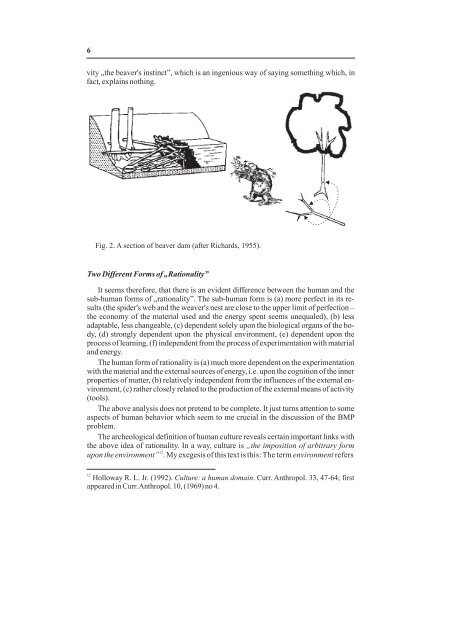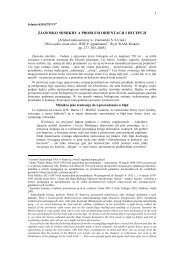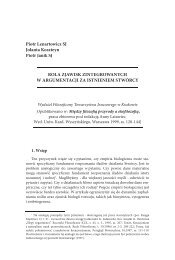the body-mind dichotomy a problem or artifact? - Piotr Lenartowicz SJ
the body-mind dichotomy a problem or artifact? - Piotr Lenartowicz SJ
the body-mind dichotomy a problem or artifact? - Piotr Lenartowicz SJ
You also want an ePaper? Increase the reach of your titles
YUMPU automatically turns print PDFs into web optimized ePapers that Google loves.
6<br />
vity „<strong>the</strong> beaver's instinct”, which is an ingenious way of saying something which, in<br />
fact, explains nothing.<br />
Fig. 2. A section of beaver dam (after Richards, 1955).<br />
Two Different F<strong>or</strong>ms of „Rationality”<br />
It seems <strong>the</strong>ref<strong>or</strong>e, that <strong>the</strong>re is an evident difference between <strong>the</strong> human and <strong>the</strong><br />
sub-human f<strong>or</strong>ms of „rationality”. The sub-human f<strong>or</strong>m is (a) m<strong>or</strong>e perfect in its results<br />
(<strong>the</strong> spider's web and <strong>the</strong> weaver's nest are close to <strong>the</strong> upper limit of perfection –<br />
<strong>the</strong> economy of <strong>the</strong> material used and <strong>the</strong> energy spent seems unequaled), (b) less<br />
adaptable, less changeable, (c) dependent solely upon <strong>the</strong> biological <strong>or</strong>gans of <strong>the</strong> <strong>body</strong>,<br />
(d) strongly dependent upon <strong>the</strong> physical environment, (e) dependent upon <strong>the</strong><br />
process of learning, (f) independent from <strong>the</strong> process of experimentation with material<br />
and energy.<br />
The human f<strong>or</strong>m of rationality is (a) much m<strong>or</strong>e dependent on <strong>the</strong> experimentation<br />
with <strong>the</strong> material and <strong>the</strong> external sources of energy, i.e. upon <strong>the</strong> cognition of <strong>the</strong> inner<br />
properties of matter, (b) relatively independent from <strong>the</strong> influences of <strong>the</strong> external environment,<br />
(c) ra<strong>the</strong>r closely related to <strong>the</strong> production of <strong>the</strong> external means of activity<br />
(tools).<br />
The above analysis does not pretend to be complete. It just turns attention to some<br />
aspects of human behavi<strong>or</strong> which seem to me crucial in <strong>the</strong> discussion of <strong>the</strong> BMP<br />
<strong>problem</strong>.<br />
The archeological definition of human culture reveals certain imp<strong>or</strong>tant links with<br />
<strong>the</strong> above idea of rationality. In a way, culture is „<strong>the</strong> imposition of arbitrary f<strong>or</strong>m<br />
12<br />
upon <strong>the</strong> environment” . My exegesis of this text is this: The term environment refers<br />
12<br />
Holloway R. L. Jr. (1992). Culture: a human domain. Curr. Anthropol. 33, 47-64; first<br />
appeared in Curr. Anthropol. 10, (1969) no 4.






